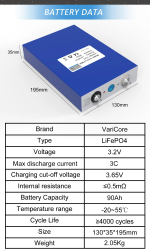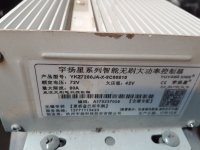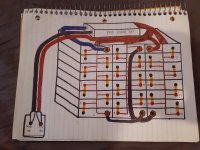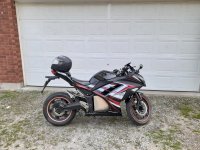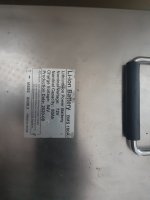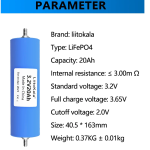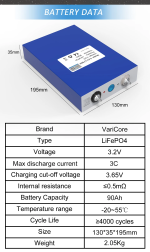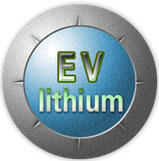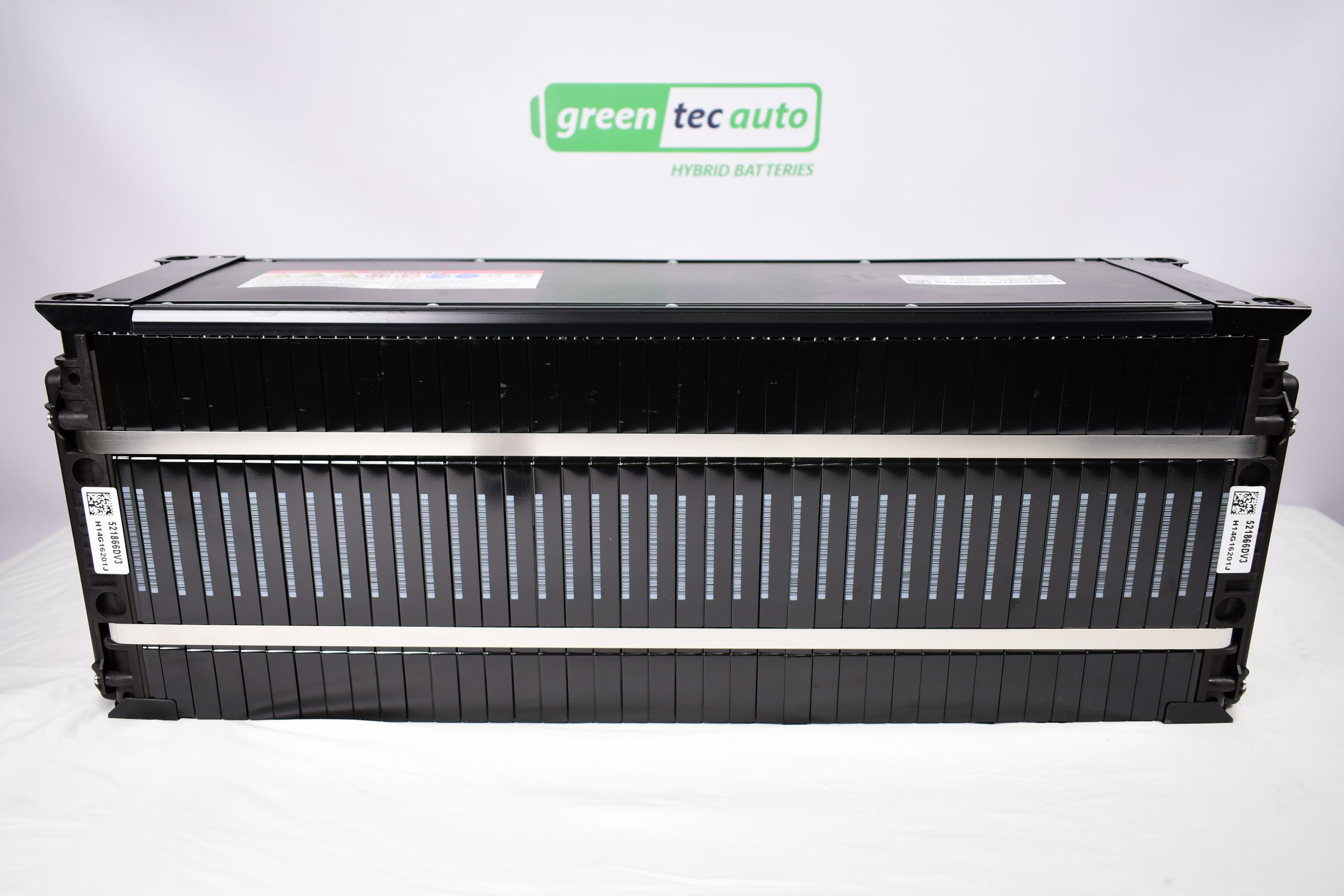ElectricGSXR
10 W
I'm new here so I'd like to first say hello. I'll apologize in advance if any of my questions or statements seem stupid as I am new to all of this and it is a lot to process.
I am in a bit of a pickle. I have to get a new battery for my electric motorcycle. I don't like the looks of the ones (that I can find for sale) on amazon.ca and I don't know where to get another one. I know I could most likely go to the place where they sell the Emmo bikes and try to get a new Lit-Ion battery there but it would cost a lot to get another like the one I had which was 72v 80Ah Lith-Ion with 100amp BMS - I took a picture of that information. The bike that I have has a 3000w rear hub motor, I am uncertain of the peak watt rating of my particular motor but when checking a similar QS hub Motor online today it says 3000w / 8000w peak. I have no idea what controller I have which is something I should probably check soon.
I have been looking at a lot of information on the internet and videos on YouTube and I think that I could likely take on the task of building one for myself. The cells I would use are a 3.2v 90Ah rated for C3 so that's 270amps? The C rating is confusing me. Link for battery below.
I'll connect them in 24S to get my 72v which is the option on the Daly BMS I am thinking about getting. I am not set on Daly but have read mostly good things. I have read however that you can't really trust the ratings that they say for any of the BMS' you buy from China and that's exactly where I plan on getting my stuff from, but the bike came from China in the first place so the BMS originally in the battery was from China and it worked fine. Had it for 3 years and I ride as much as I can. I think it just ran its life. My old battery pack had a 100amp BMS but I'm not sure of the peak and I cant find the peak ratings on the Daly BMS shown below it only shows the amps. I am not really sure if I need to get a bigger BMS or not if I make a new battery with those cells.
Link for the Daly BMS I am considering below, its the 72v 24S LiFePO4 version. Not sure on the amp rating I need though. I cant find the peak amp ratings there either but maybe I'm just not seeing it.
I did calculations for my motor @ 3000w + 15% as was advised in something I read, so 3450w divided by 72v is about 48amps
I also did the 8000w peak divided by 72 which is around 111amps
Then I did calculations for when the battery pack's voltage is full which I got as 88v at 100% full and a lower voltage at 40% which was around 47v.. If that makes sense.
So I got 3450w divided by 88v (100% full) = 40amps
and 3450w divided by 74v (at 40%) = 74amps
I figured I would check what I thought would be the worst case scenario which was the motor peaking at 8000w divided by 47v = 170amps peak
With that all gathered & assuming its correct... I'm guessing my old BMS was 100amp with close to 200peak? Would something like that work with the battery pack I plan on making?
Again, the cells are: 3.2v 90Ah 3C Max Discharge in 24S so the pack is: 72v 90Ah 3C Max Discharge.
For my controller I mean I honestly don't know much about them. I have to check which one I have and everything still. I don't have the software or anything (if there was anything) since I bought the bike from a friend and they aren't living in the same city anymore. I really want to get a new controller as well so I can have the option to manage and monitor different things in the future.
This has gotten my brain activated for sure. I'm confused but slowly gathering little bits. Any help appreciated.
I am in a bit of a pickle. I have to get a new battery for my electric motorcycle. I don't like the looks of the ones (that I can find for sale) on amazon.ca and I don't know where to get another one. I know I could most likely go to the place where they sell the Emmo bikes and try to get a new Lit-Ion battery there but it would cost a lot to get another like the one I had which was 72v 80Ah Lith-Ion with 100amp BMS - I took a picture of that information. The bike that I have has a 3000w rear hub motor, I am uncertain of the peak watt rating of my particular motor but when checking a similar QS hub Motor online today it says 3000w / 8000w peak. I have no idea what controller I have which is something I should probably check soon.
I have been looking at a lot of information on the internet and videos on YouTube and I think that I could likely take on the task of building one for myself. The cells I would use are a 3.2v 90Ah rated for C3 so that's 270amps? The C rating is confusing me. Link for battery below.
I'll connect them in 24S to get my 72v which is the option on the Daly BMS I am thinking about getting. I am not set on Daly but have read mostly good things. I have read however that you can't really trust the ratings that they say for any of the BMS' you buy from China and that's exactly where I plan on getting my stuff from, but the bike came from China in the first place so the BMS originally in the battery was from China and it worked fine. Had it for 3 years and I ride as much as I can. I think it just ran its life. My old battery pack had a 100amp BMS but I'm not sure of the peak and I cant find the peak ratings on the Daly BMS shown below it only shows the amps. I am not really sure if I need to get a bigger BMS or not if I make a new battery with those cells.
Link for the Daly BMS I am considering below, its the 72v 24S LiFePO4 version. Not sure on the amp rating I need though. I cant find the peak amp ratings there either but maybe I'm just not seeing it.
I did calculations for my motor @ 3000w + 15% as was advised in something I read, so 3450w divided by 72v is about 48amps
I also did the 8000w peak divided by 72 which is around 111amps
Then I did calculations for when the battery pack's voltage is full which I got as 88v at 100% full and a lower voltage at 40% which was around 47v.. If that makes sense.
So I got 3450w divided by 88v (100% full) = 40amps
and 3450w divided by 74v (at 40%) = 74amps
I figured I would check what I thought would be the worst case scenario which was the motor peaking at 8000w divided by 47v = 170amps peak
With that all gathered & assuming its correct... I'm guessing my old BMS was 100amp with close to 200peak? Would something like that work with the battery pack I plan on making?
Again, the cells are: 3.2v 90Ah 3C Max Discharge in 24S so the pack is: 72v 90Ah 3C Max Discharge.
For my controller I mean I honestly don't know much about them. I have to check which one I have and everything still. I don't have the software or anything (if there was anything) since I bought the bike from a friend and they aren't living in the same city anymore. I really want to get a new controller as well so I can have the option to manage and monitor different things in the future.
This has gotten my brain activated for sure. I'm confused but slowly gathering little bits. Any help appreciated.
Last edited:


